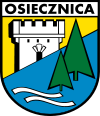Osiecznica
| Osiecznica | ||
|---|---|---|

|
|
|
| Basic data | ||
| State : | Poland | |
| Voivodeship : | Lower Silesia | |
| Powiat : | Bolesławiec | |
| Geographic location : | 51 ° 20 ' N , 15 ° 25' E | |
| Residents : | 1000 | |
| Postal code : | 59-724 | |
| Telephone code : | (+48) 75 | |
| License plate : | DBL | |
| Economy and Transport | ||
| Street : | Osiecznica– Lubań | |
| Next international airport : | Wroclaw Airport | |
| Gmina | ||
| Gminatype: | Rural community | |
| Gmina structure: | 11 localities | |
| 8 school offices | ||
| Surface: | 437.07 km² | |
| Residents: | 7396 (June 30, 2019) |
|
| Population density : | 17 inhabitants / km² | |
| Community number ( GUS ): | 0201052 | |
| Administration (as of 2015) | ||
| Community leader : | Waldemar Nalazek | |
| Address: | ul.Lubańska 43 59-724 Osiecznica |
|
| Website : | www.osiecznica.ug.gov.pl | |
Osiecznica [ ɔɕɛˈt͡ʃɲit͡sa ], German Wehrau , is a village and capital of the rural community of the same name in the western part of Poland - about 70 km south of Zielona Góra ( Grünberg ) and 120 km east of Dresden in the powiat Bolesławiecki of the Lower Silesian Voivodeship . The municipality is a member of the Neisse Euroregion and has around 7,000 inhabitants.
history
Rule of Wehrau
In the Middle Ages, Wehrau was on a sovereign territory in Upper Lusatia . When Duke Johann von Görlitz pledged the heather area between Großer Tschirne and Queis to the Lords of Rechenberg on Klitschdorf in 1393 , the Klitschdorf rulership of Upper Lusatia came into being , which the Rechenbergers received as a fief from Emperor Rudolf II in 1579 .
Between 1612 and 1631 the rulers of Wehrau and Klitschdorf were separated, with the owners of the Wehrau rulership taking their seat in Tiefenfurt from 1620 . In 1690, Balthasar Erdmann Graf von Promnitz on Sorau , Triebel , Halbau , Burau and Freiwaldau also became the owner of Wehrau, who had a castle built in the same year by the builder Giulio Simonetti from Graubünden . He changed the name of the rulership to Wehrau .
Since 1725 Wehrau was no longer a rule, but merely a heritage that was reunited with the rule of Klitschdorf in 1747 . In 1800 Johann Christian Reichsgraf zu Solms-Tecklenburg was the owner of the estate.
Village
The village of Wehrau was a center of glass, iron and paper production. The glassworks built in the middle of the 19th century was restructured in 1936 to become the Andreashütte glass cutting shop . As early as 1690, Count von Promnitz had a blast furnace built to smelt the lawn iron ore from Heiligensee, and in 1786 another was in operation. In 1861, two fresh fires and two steel hammers were operated in Eisenhammer Wehrau. The iron hammer went into the ironworks and enamel factory Lorenzdorf in 1869 . A paper mill was already in operation in the village in the 16th century, two paper mills are reported in 1786, but they ceased operations towards the end of the 19th century.
The stately limestone quarries, into which several dewatering tunnels were driven and provided work for numerous residents, were important. There were also sandstone quarries between these quarries and the village.
After 1815 Wehrau was in the Prussian part of Upper Lusatia and in 1818 was assigned to the Silesian district of Bunzlau with the ruling villages .
With the construction of the railway between Hirschberg and Sagan in 1904, Wehrau got a railway connection. In 1825 there were 2,500 inhabitants in Wehrau and the village had over 400 houses. In 1939 there were only 793 inhabitants.
In Osiecznica, which has been part of Poland since 1945, there is a branch of the Quarzwerke Group for the extraction of quartz sand for the glass and ceramics industry.
A geological specialty is the Teufelswehr , a waterfall of the Queis , which breaks through a mountain formation here.
Sons and daughters of the place
- Edgar Rabsch (1928–1990), German organist, choir director and composer
- Friedrich zu Solms-Baruth (1886–1951), German resistance fighter and nobleman
- Abraham Gottlob Werner (1749-1817), German mineralogist
Gmina
The rural municipality of Osiecznica has eight school offices that administer the following localities:
- Kliczków (Klitschdorf)
- Luboszów (Lipschau-Dohms)
- Ławszowa (Lorenzdorf)
- Osiecznica (Wehrau)
- Osieczów (Aschitzau)
- Ołobok ( Millbuck )
- Parowa (Tiefenfurt)
- Poświętne (Holy Lake )
- Przejęsław (Prince Village)
- Świętoszów (Neuhammer a. Queis)
- Tomisław (Thommendorf)
Świętoszów is the location of a military training area , which was the largest in Silesia as the Neuhammer military training area before 1945 .
Web links
- Municipality website (Polish)
Individual evidence
- ↑ population. Size and Structure by Territorial Division. As of June 30, 2019. Główny Urząd Statystyczny (GUS) (PDF files; 0.99 MiB), accessed December 24, 2019 .
- ↑ Website of the municipality, Spis telefonów i numerów wewnętrznych ( memento of the original from February 26, 2017 in the Internet Archive ) Info: The archive link was inserted automatically and has not yet been checked. Please check the original and archive link according to the instructions and then remove this notice. , accessed February 17, 2015



